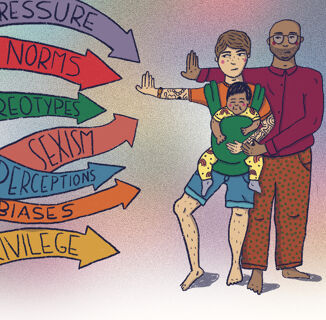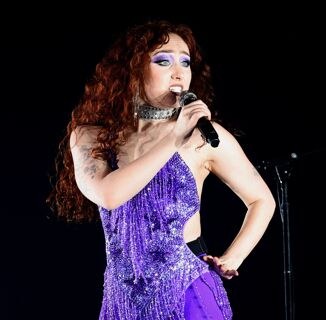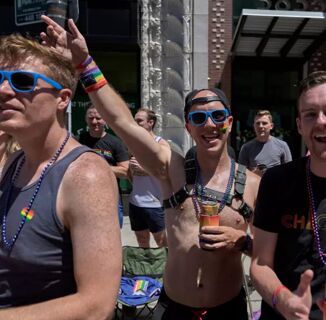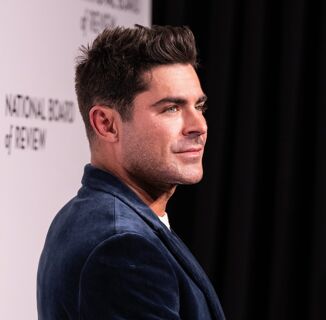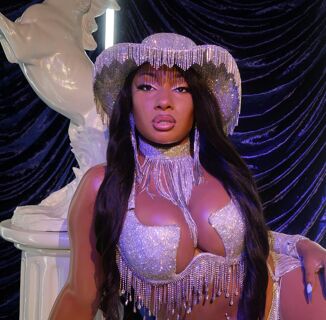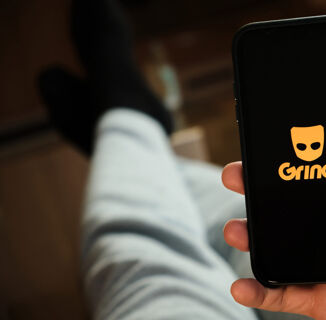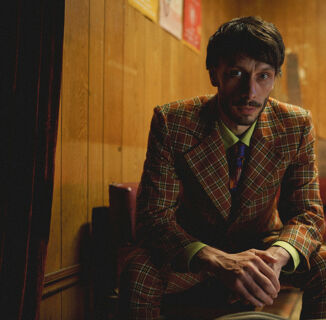On a Saturday afternoon in Hollywood, a room filled with Latino filmmakers, producers and general Hollywood types hangs on Steven Canals’ every word. We’re sitting in neat rows of chairs in a hotel conference room at the official 2018 media summit for the National Association of Latino Independent Producers and everyone wants to know more about Canals, the queer Afro-Latinx creator of Pose, but even more, people want to know how it all happened.
They want to know how Pose made its way onto one of television’s hottest channels and how Canals came to work with TV mega producer Ryan Murphy, who became Pose’s executive producer. They want to know how Canals overcame the number of doors slammed in his face. They want to know how something so queer, so black and so brown somehow made it onto our screens.
Pose’s very existence is impressive. But the true miracle, Canals insists, is that queer people get to make it. It features the largest cast of transgender actors ever assembled. The show’s own Janet Mock is the first trans woman to write, direct and produce a television series. At every level of creation in front of and behind the camera, queer people mold the show. And before its season finale aired, FX announced a second season.
“I’m concerned not so much with ‘Are the stories being told?’ but who is telling the story,” he says to applause. “I think we have not been allowed in the room to tell our own narratives.”
He specifically cites the importance of his Pose trans collaborators Mock and Our Lady J, who also writes and produces.
“For us to have a seat at the table to tell that story, that’s progress,” he adds. “That’s how you’re going to see narratives that will open up discourse in healthy, critical way. For too long, that hasn’t been happening.”
Canals discusses serious complex realities like colorism, transphobia and intersectionality all while making everyone, including myself, guffaw. Pose is a serious show — it tackles the lives of black and brown queer and trans people living through the simultaneous epidemics of poverty, HIV and drugs in 1980s New York City. But Canals is all smiles and levity. He draws laughter out of you. It’s a skill he wields in public as he continues to speak in support of the fledgling series that could.
He’s the writer, executive producer and creator of one of the queer community’s favorite shows, but in his sneakers, glasses and enamel pin-laden denim jacket, he just looks like familia. When his fellow panelist (and One Day At a Time star) Isabella Gomez tells a story about her friend “Rita,” and clarifies that she means “Rita Moreno,” Canals lifts his mic up and says, “Girl, we know.” The room and his fellow panelists burst into even deeper laughter.
As magnetic as Canals is, he’s also adept at sharing credit. He possesses an uncanny generosity that lends itself perfectly to Pose’s ethos. He’s not just about making sure his story is told: he wants to make sure that everyone has a seat at the table. When audience members and panelists praise Pose, he makes sure the audience walks away hearing the names Ryan Murphy, Brad Falchuk, Janet Mock, and Our Lady J. He speaks about his fellow producers like the characters on Pose might discuss the House of Evangelista — with love. Later, in private, he jokes that the writers’ room dubbed itself the House of Murphy.
During its first season, Pose jostled its way onto every queer person’s calendar, their Twitter fingers going into overdrive every Sunday night to discuss the show’s characters and the complex psychological world they dared to inhabit. But, how did Canals go from working as a student affairs administrator in eastern Pennsylvania to tweeting along with his #PoseFamily every Sunday night in only a few short years?
The show’s origin story, it turns out, is shade.

In 2012, Canals was a college administrator at a university in Pennsylvania. A resident assistant during his undergraduate years, he was unsure if a career behind the camera called to him — and several professors dissuaded him from his artistic pursuits. He fell into student affairs and worked in a campus multicultural office telling students that they should be their best selves. All the while, he ignored his own creative impulses.
“I felt like a fraud,” Canals said to me in his Los Angeles home. His apartment is uncluttered and open. The most dominating visual in the room is a big book bearing Keith Haring’s name. He also wore a t-shirt with the legendary gay artist’s recognizable figures on the chest. He’s laid out cheese, grapes and preserves. His denim jacket and my own were hanging side-by-side next to the door.
One evening, an art professor invited Canals to a soiree at his apartment with other artists. Canals said another creative approached him and asked him, “What’s your art?” At that moment, the art professor happened to be walking by and muttered, “He’s not an artist.”
Canals called the moment “soul crushing.”
“I’d never given myself the label of ‘artist,’ but at that moment, having it taken away from me, it didn’t feel good,” he said. He had contemplated returning to school for some time and, within a month of the incident, he turned in his application to UCLA’s MFA screenwriting program.
Pose didn’t come to life until Canals’ final semester in the program. Burnt out from writing features, he felt his idea well had run dry. All he had in his back pocket, he thought, was a semi-autobiographical piece about Bronx in the 1980s. But it didn’t feel right. A graduate program in screenwriting, he says, is all about branding, and he had branded himself as the gritty, urban scribe. The story seemed to fit his brand, but it wasn’t the right moment.
“At the time, I didn’t have the confidence as a writer,” he said. “I didn’t know if I was the person who should tell the story or if I was ready to tell it.” On a walk near campus, his friend, The Magicians writer Noga Landau, prodded him until he realized his back pocket held one more idea.
In 2004, as an undergraduate at Binghamton University, Canals watched Paris Is Burning for the first time. The film stuck with him not only for its historical significance, but for the potential of even more stories in the world its director Jennie Livingston chronicled. Later, as he walked through the residence halls a name popped into his head — Damon, the name of a young boy who would move to New York City and enter the ball culture.
Canals, and Hollywood, slept on Paris Is Burning for a long time. At one point, Precious director Lee Daniels was meant to helm a musical version of the film for television. And prior to Pose, Murphy bought the rights to Livingston’s documentary, set on making another hit TV show based off its characters.
Ten years after watching Burning in class, Canals wrote the pilot for Pose in just 10 weeks.

Canals is a natural storyteller. To hear him answer a question is to be brought to another world. His answers contain beginnings, middles and ends. When I ask him about being a writer, his whole family plays the cast in his answer.
Born and raised in the Bronx, Canals let his parents turn him into a genre cinephile. He learned story from a steady diet of highbrow popcorn flicks like Terminator 2, Alien, and Aliens, movies his father loved. His mother, an educator, read to him at night. Sometimes, she concocted his bedtime stories in her own head. Canals’ media leash was long.
“They let me watch whatever and we’d have a conversation about it after,” Canals said. “Nothing was off limits.”
Even in play, Canals couldn’t leave story behind. While other kids played freeform with their action figures, Canals invented scenarios and crafted yarns for his Thundercats and Ninja Turtles figures.
“I used to suck the fun out of play,” he said. “I was the kid that had a notebook and would write down storylines.”
Canals was 15 when he knew his love for story would translate to a career. With an after-school arts program, he and other students in his 10th grade class produced a documentary about gang violence with help from a then-fledgling HBO Family. Canals and his friends interviewed community members and worked for eight months to create the final product. But as they came to the end of the academic year, one of his peers — a co-producer on the film — was shot and killed.
“Her death was for me … I think it’s one that I still haven’t quite emotionally processed to be honest,” Canals said. “We went from highlighting a very particular experience to all of a sudden having that experience of loss at 15 and not having the emotional intelligence to comprehend how it could happen.”
With life imitating art, Canals said this is when the power of film and television truly resonated with him. These stories were not just there to entertain — they could educate.
“I think that’s where my own personal work always lives,” Canals said. “I always want to live at the intersection of [education and entertainment].”
And Pose does. The show traffics as much in queer reality as it does in queer fantasy. As much as it depicts queer and trans people’s lived experiences, Canals and the rest of the writer’s room knew that they’d be writing scenes never before depicted on television. For instance, Murphy and Canals knew that when Blanca spoke to Damon about gay sex, it would be the first time a young queer kid on television got “the talk” from his mother.
“The first time that I went to go attack the page, the first draft was super clinical,” Canals said. It felt as if Canals had just Googled a checklist about queer sexual health. “It wasn’t funny. The humor had been sucked right out of the conversation.”
After a quick kiki with Murphy and four days of rewrites, Canals said they arrived at the final conversation, which covered tops, bottoms, and more. Canals described the final scene as an “honest conversation” between a son and his mother — “a mother who happens to have a young boy who’s attracted to boys.”
“You can research any particular topic as much as you want until you’re blue in the face,” Canals said. “When it comes to crafting the narrative, you have to let all that go. You just have to tell the story.”

Storylines around HIV also showed Canals and crew’s deft ability to toe the line between information and amusement. In episode four, ballroom MC Pray Tell talks to the young queer men in the House of Evangelista about getting tested in a restaurant booth. Scenes later, Pray Tell takes the younger generation to test at a clinic. And in episode six, he throws an AIDS cabaret to honor his dying lover. Canals said that the former plotline is meant to send a message, while the latter is meant to send the viewer a message about humanity.
While Pose does employ fantasy, it does so in the pursuit of justice. Canals said that every week, he received tweets during beats of the show about the character Angel (Indya Moore), who pursues a relationship with the upper middle class banker Stan (Evan Peters). He’d see tweets concerned for Angel’s safety, considering how much violence against trans women is often intimate partner violence. Canals saw the disconnect early on when the scene the writer’s room had concocted as the beginning of a love story between Angel and Stan was taken as a dangerous moment for Angel.
But, Canals said, that’s not what they wanted to portray. The life of Venus Xtravaganza, one of the most infamous members of New York City’s ballroom scene, and star of Paris Is Burning, inspired the character. Yet Angel is meant to be a blueprint for what her life could’ve been if she weren’t killed.
“We looked at Venus’s life and art in the documentary, and everyone was so moved and touched by her,” he said. “We decided to honor her by telling a story where that’s not her ending.”
Other characters take inspiration from Canals’ own life, as well. His favorite character to write is Blanca Evangelista, inspired, he said, by his own mother. Her love is a tough love: she forces Damon to apply for dance school, but only to meet his potential.
“Blanca is a fighter and my mom is — she’s just resilient,” he said. After our conversation, Canals took a moment to go to his room and came back with three pictures of his mother in the late 1970s and early 1980s. One picture has Canals as a baby.
“Blanca is truly just my mom on the page,” he said. “I understand her and understand how to write for her from growing up in a household with three really strong, complex, intelligent outspoken Black and Puerto Rican women.”
And as for Lil Papi, a young homeless Latinx man trying to get out of the drug game, he’s inspired by straight men Canals knew growing up in the Bronx who had no qualms with Canals being queer. Canals wrote an impassioned email to Ryan Murphy defending the character of Lil Papi being male after the writer’s room had a large discussion about whether they should change the character to be a lesbian. However, so much of Lil Papi came from Canals’ upbringing that he didn’t want to see the character’s gender altered.
On the first day that Angel Curiel, the actor playing Lil Papi, came to set, Canals said Murphy gave him the greatest compliment yet: “I’m glad you fought me on that one.”

Pose has proved to be a years-long lesson in what it means to be an Afro-Latinx creator in Hollywood. After writing the first draft in 2014, Canals said the show’s first pitches landed with a huge thud.
“Pose opened every single door, but it would not keep me in the room,” he said. Executives would say it was too niche or use coded terms like “urban” to suggest that it wouldn’t connect with viewers. Everyone was enamored with the strength of the pilot; no one would foot the bill to see it realized.
Enter Ryan Murphy. Canals first met with Murphy in September 2016, days after Murphy won nine trophies at the Emmy Awards for The People v. O.J. Simpson: American Crime Story, Canals’ personal favorite series of that year. Canals had been a fan of Murphy’s since Popular, his short-lived but much-loved WB series. The two spent 45 minutes together discussing Pose and what it might look like to work together. Canals said that with most pitches, he strayed conservative, not giving away too many details. But with Murphy, he put all his cards on the table.
“I felt like the ball had been in his court, but my team had been mindful about saying, ‘In reality, it’s in yours,’” he said. “You can go in there and if you don’t get along with him or you feel like it’s not the right fit, you don’t have to work with him.”
But, after the 45 minutes had ended, Canals knew the pair would be a fit. Canals said there was one moment that cinched that Murphy understood his vision for the show. Like every other executive, Murphy asked him who he envisioned in the series. When Canals couldn’t name big name actors to star as the show’s five central characters, most executives’ eyes glazed over. To Murphy, Canals said: “I don’t know, I haven’t met them yet.”
When Murphy agreed with Canals’ instincts, the two became a pair.
Murphy, Canals, and frequent Murphy collaborator Brad Falchuk began re-imagining Canals’ original script. The Damon storyline of the dancer coming to New York City was brought over wholesale from the original, but Murphy did make a few changes. He owned the rights to Paris Is Burning and, at one point, Pose had fictional characters interacting with real people like Pepper LaBeija and Dorian Corey. But that was eventually scrapped. Canals admits that for his own personal taste, authentic has always meant gritty, but Murphy suggested that the tone be lighter. Canals worried the show might veer into Glee territory when it came to lightness, but Murphy assured him that that was not what he was talking about.
“The word for the writer’s room for the entire season was ‘aspirational,’” he said. For Canals, the tone of Pose was so much larger than just how the viewer might receive it. Potentially flubbing the show might in turn cost himself and other creators of color jobs. Canals said the fate of Pose weighed heavy on him in that way.
“If I fuck up, then I just shut the door for everyone else who’s come after me,” he said.
Canals thinks about his relative privilege in the industry all the time. When I ask him how long it took for his own impostor syndrome to wear off, he replied, “I don’t think it has.”
Canals launched into a story, his modus operandi. He said a friend of his, a woman who’s been around the Hollywood block, explained to him that Tinseltown is a tugboat filled with white men. Every once in a while, the white men allow one person unlike them onto the ship, but it’s only one at a time and only when they feel like extending the invitation. They let you into the room and they usher you back out.
“Aside from reaching over and pulling people out of the water onto the boat, the other option, which is equally as important is to say, ‘Fuck it!’ and build another boat,” Canals said. “Just build my own goddamn boat, I’ll decide who is on it.”
Canals’ dedication to getting Hollywood a bigger boat probably stems from his own confusion as to why he is here rather than anyone else he grew up with. Why does he have a show on FX and others from the Bronx don’t? Why does he have a show with several trans writers, directors and actresses of color? He doesn’t know the answer.
“I’m always going to have that feeling of ‘I don’t know why I got here,’” he said. “I don’t know why the universe selected me as the person to make it out of that environment. There’s plenty of people with the same story as me, born and raised in the Bronx in the 1980s that don’t have the same opportunities I’ve had.”
“I don’t know why the universe decided I would be the person,” Canals said, “but I’m grateful for it.”
Photo Credit: Alex Schmider/INTO
Help make sure LGBTQ+ stories are being told...
We can't rely on mainstream media to tell our stories. That's why we don't lock our articles behind a paywall. Will you support our mission with a contribution today?
Cancel anytime · Proudly LGBTQ+ owned and operated
Read More in Culture
The Latest on INTO
Subscribe to get a twice-weekly dose of queer news, updates, and insights from the INTO team.
in Your Inbox

